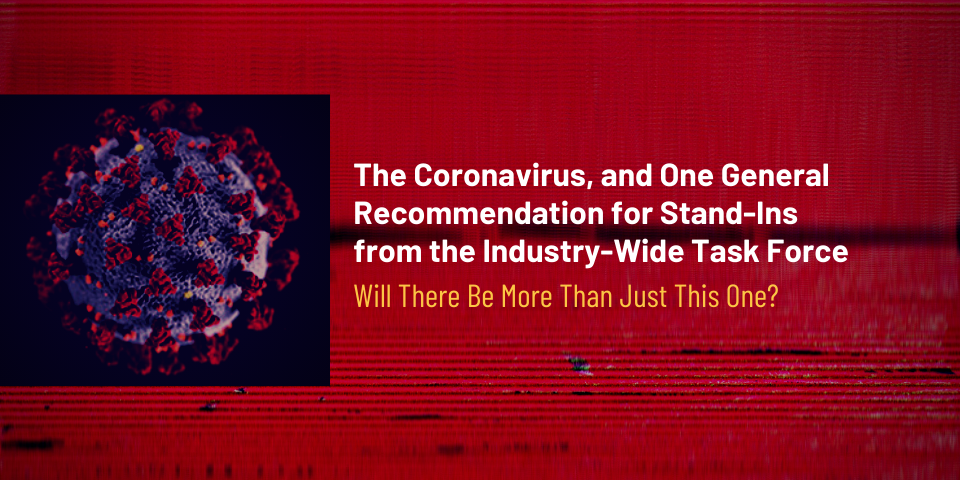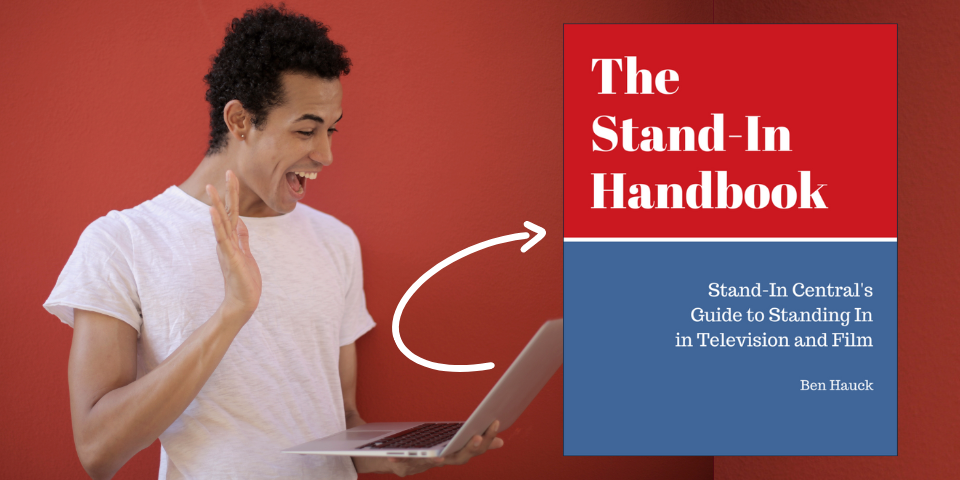This post is part of Stand-In Central’s deep-dive series into the coronavirus pandemic as it relates to stand-in work in TV and film. For more posts in the long-running series, visit https://standincentral.com/coronavirus.
— The Editor
On June 1, 2020, the Industry-Wide Labor Management Safety Committee Task Force (“Task Force”) submitted to the offices of California Governor Gavin Newsom and New York Governor Andrew Cuomo its 22-page “White Paper” document titled “Proposed Health and Safety Guidelines for Motion Picture, Television, and Streaming Productions During the COVID-19 Pandemic.”
(Stand-In Central readers may download here the version dated June 1, 2020.)
The Alliance of Motion Picture and Television Producers (AMPTP), the body that represents producers at the bargaining table across from stand-ins’ union SAG-AFTRA, developed these “proposed recommendations” alongside “various unions of the motion picture and television industry.”
Does the Document Address Stand-Ins at All?
In the 22-page document, stand-ins are mentioned once, on page 18.
Under the heading “Special Considerations for Performers,” there is a bullet point that reads:
Stand-ins should wear face coverings even if the performer they are standing in for may not.
So, without any further clarification, the Task Force “recommends” that stand-ins wear some kind of face covering when they are working.
This would imply that while being lit by a director of photography or while rehearsing a scene with the camera department and director, stand-ins “should” keep on their face coverings and not take them off.
While other guidelines in the document may apply to stand-ins — such as physical distancing, hand washing, etc. — there are no other specific guidelines for stand-ins within the document.
To wit, these guidelines are meant to be general rather than exhaustive, and individual governments or productions may have more refined guidelines for stand-ins at a later time.
How Do These Guidelines Classify Stand-Ins? As “Cast,” “Crew,” or Something Else?
Aside from that one mention of stand-ins, the document speaks of “cast and crew,” which might startle stand-ins given the obvious classification issues with which they have dealt for a long time. Those classification issues cause stand-ins, time and again, to fall through the cracks with respect to safety, training, and related issues, which Stand-In Central has documented over the years.
However, the document clarifies to what the noun phrase “cast and crew” refers:
Note: Numerous different job roles are involved in the industry, including pre- and post-production staff, cast, craftspersons, laborers, and many others. To avoid confusion, the term “cast and crew” is used throughout to refer to any/all individuals who are involved in the production process.
Given this note, stand-ins should assume they are represented by the noun phrase “cast and crew” because stand-ins are “individuals who are involved in the production process” — even though the document does not clarify into which slot stand-ins fall — “cast” or “crew.”
Which Stand-Ins These Guidelines May Cover … and May Not Cover
In general, the AMPTP represents producers of feature films and dramatic television productions using SAG-AFTRA’s Television/Theatrical Agreement.
Most stand-ins in TV and film work under this agreement, which is also called the “Basic Agreement.”
Other stand-ins work under SAG-AFTRA’s Network Television Code (“Netcode”), on shows like late-night variety series, awards shows, and daytime talk shows, which generally have live studio audiences.
The Netcode is not negotiated with the AMPTP, but instead with a small collection of major television networks, some if not all of whom participate in the Task Force (per the document’s appendix).
However, it is unclear whether any of the proposed recommendations in this document would have any influence on the work of stand-ins working under the Netcode. Unofficially, according to Katie Von Till and Amir Talai on June 3, 2020, during a “You Are The Union” livestream event hosted by SAG-AFTRA political party Unite for Strength, these guidelines applies to “all productions,” at least meaning both Basic Agreement stand-in jobs and Netcode jobs.
What Informs These Guidelines?
The proposed recommendations in the document “outline guidance regarding protective measures to be used.”
As “guidelines,” they are “based on discussions with health experts, guidelines issued by U.S. Centers for Disease Control and Prevention (CDC) and the Occupational Safety and Health Administration (OSHA), and input from industry participants familiar with the working conditions of motion picture and television production.”
What Else?
Earlier today, The Acting Income Podcast released a new episode titled “The Return to Work: The Coronavirus, SAG-AFTRA, and Some Uncommon Sense about Actors’ Rights and Safety.”
In addition to covering tips and rights for actors that would as well apply to SAG-AFTRA stand-ins, the podcast questions the logic that actors cannot always wear personal protective equipment (PPE) when they are working.
Given these proposed recommendations from the Task Force, it seems that its more than 40 participant-organizations assume on the whole that actors cannot always wear PPE when they are working. In other words, they assume that actors must be able to do their acting work without wearing PPE.
I encourage you to listen to the podcast episode for reasoning why the claim that actors cannot always wear PPE when they are working needs to be challenged and reconsidered for lack of data and for its inconsistency with an interest in safety
In addition to being available on popular podcast apps, the episode is also available on YouTube:
What Next?
It’s unclear how long the California and New York governors will take in their consideration of this document.
SAG-AFTRA said in an article posted on Deadline on June 2, 2020:
This document is an initial set of principles and guidelines that we all agree form a relevant and realistic first step to protecting cast and crew in the reopening of the entertainment and media industry in its two largest markets. As we have reported previously, our draft protocols are being developed with advice and input from our epidemiologist and industrial sanitation experts, with guidance from member leaders, staff, our fellow unions and labor relations and sanitation officials. Our protocols will be completed and released in the coming days.
So, as they say in television: Stay tuned.
Thoughts? Insights? Suggestions about these “proposed recommendations” on the return to work, especially as a stand-in? Post your comments below!







Leave A Comment